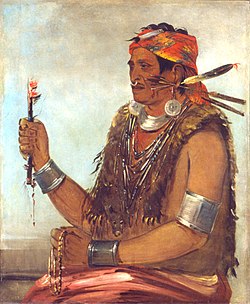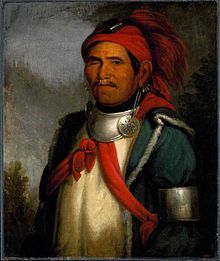Tenskwatawa

Tenskwatawa[pronunciation?] (also called Tenskatawa, Tenskwatawah, Tensquatawa or Lalawethika) (January 1771 – November 1836) was a Native American religious and political leader of the Shawnee tribe, known as the Prophet or the Shawnee Prophet. He was a brother of Tecumseh, leader of the Shawnee. He was originally given the name Lalawethika ("He Makes a Loud Noise" or "The Noise Maker"). He denounced Americans as children of the Evil Spirit and mobilized the Indians in the Midwest to fight them, but his movement was defeated during the War of 1812 when his brother was killed, and he went to the area now known as Argentine, Kansas.
Early years

Tenskwatawa's mother was Methoataske (or Methoataaskee, meaning "[One who] Lays Eggs in the Sand"), who was believed to be either Muscogee Creek, Cherokee, or Shawnee, possibly of Pekowi division and the Turtle Clan.[1][2]
Even though he quickly became famous later on in life, Tenskwatawa spent his early years unpopular and drunk. Part of a set of triplets born to Puckeshinwa and Methoataske in 1768 in Ohio, Tenskwatawa was unlucky from the start. Before Tenskwatawa was born, Puckenshinwa, a leader of the Kispokotha division of the Shawnee Tribe, was killed by a British soldier in the Battle of Point Pleasant. Methoataske was so frightened by the American Revolution, and so depressed by the death of her husband that she fled back to her Creek relatives, leaving Tenskwatawa and his siblings in the care of their older sister, Tecumpease. Tenskwatawa and his triplet brother (the other triplet died during birth) were the youngest of the three daughters and five sons. Tenskwatawa was especially unpopular. While Chiksika, his oldest brother and a leading warrior, would take his brothers out to hunt and fight in small battles, Tenskwatawa would stay behind because he lacked the skills his brothers possessed. Tecumseh, one of the oldest, was an especially gifted athlete, and became the favorite of most of the tribe. Left alone and insecure, Tenskwatawa attempted to make up for his athletic deficiencies by constantly boasting and making up stories about how talented and important he was, but this only resulted in him picking up the name Lalewethaka, which means "Noisemaker."
Combined with his unpopularity and isolation, Tenskawatawa was almost pushed to a breaking point when he blinded himself in his right eye while playing with a bow and arrow. His depression led him to alcoholism in his teenage years, much to the dismay of the woman he married soon after. His depression worsened and he became an alcoholic as time went on because he could not provide for his wife and kids. His luck began to change when he went to his first battle, the Battle of Fallen Timbers, in 1805, led by two of his brothers, Tecumseh and Sauwauseekau. Even though they were unsuccessful, Sauwauseekau was killed, and Tecumseh refused to sign the Treaty of Greenville, Tenskwatawa took the battle as a chance to re-insert himself back into society. A few years later, he moved with Tecumseh to a town in Indiana, where they started a small Shawnee village. It was in this village that the man formerly known as Lalewithaka became "The Prophet."
In May 1805, he experienced the first of several visions. In one of his alcoholic stupors he fell into a fire and was thought dead. Unexpectedly reviving, he recounted a powerful vision and soon began preaching. White (1991) notes that in Algonquian tradition the "Great Serpent" came from the sea and stood for evil powers; Tenskwatawa said Americans came from the sea and were the spawn of the Great Serpent.[3] He also conducted witch hunts against Christian Indians. He forbade his people to use European foods, clothing, manufactured goods and alcohol. He changed his name to Tenskwatawa (The Open Door or One With Open Mouth).
Purification
Tenskwatawa had a series of religious visions which transformed his life and led him to reject his old ways. More revelations followed in succeeding months, revelations that the European invaders from the east were “not my children, but the children of the Evil Spirit.".[4] He led a purification movement to return his people to their traditional ways, and to extirpate the evils represented by the Americans. Indian witches still remained the most active agents of that spirit on earth, and Tenskwatawa sought to identify and destroy them.[5] He formed a new community of followers near the present site of Greenville, Ohio in 1805. His following grew even more rapidly after he accurately predicted a solar eclipse in 1806 humiliating Indiana Territorial Governor William Henry Harrison. Harrison had publicly derided Tenskwatawa as a fraud to the tribal leaders and the accuracy of Tenskwatawa's prediction was taken as proof of his power by many members of the tribes.
His followers eventually followed him west to form a large multi-tribal community known to the Americans as Prophetstown or Tippecanoe in what is now Indiana in 1808. The site had both practical and spiritual significance. The site was located near the juncture of the Wabash and Tippecanoe rivers. Such places at the junction of two rivers had significant spiritual significance in tribal culture.[citation needed] The site was also a geographic central point to the political and military alliance that was forming around Tenskwatawa's brother Tecumseh.
When some chiefs tried to promote compromise and conciliation, Tenskwatawa, proclaiming his obedience to the Great Spirit, lashed out against these government sympathizing chiefs, depicting them as wicked traitors and minions of the Americans.[6]
Willig (1997) argues that Tippecanoe was not only the largest Native American community in the Great Lakes region but served as a major center of Indian culture and base to expel the whites and their culture. It was an intertribal, religious stronghold along the Wabash River in Indiana for three thousand Native Americans, Tippecanoe, known as Prophetstown to Americans, served as a temporary barrier to settlers' westward movement. Led by Tenskwatawa and Tecumseh, thousands of Algonquin-speaking Indians gathered at Tippecanoe to gain spiritual strength. US government attempts, from the George Washington to William Henry Harrison administrations, to rid the area of the numerous Indian tribes eventually met with success as the Indians retreated westward by 1840 to avoid the large numbers of American settlers entering their territory.[7]
Tecumseh's War

There is some disagreement among historians over whether Tecumseh or Tenskwatawa was really the primary leader of the Pan-Indian community that grew up around Prophetstown. Either way, Tenskwatawa's preachings grew more militant and narrowly political from 1808–1811, as more and more young disaffected warriors from nearby tribes joined his movement. By 1811, both white settlers in the region and the U.S. Army had become quite concerned about what was happening at Prophetstown.
Late in 1811, Tecumseh journeyed south to meet with representatives of other tribes in hopes of building a larger alliance, leaving Tenskwatawa in command at Prophetstown. According to legend, Tecumseh ordered Tenskwatawa to avoid any confrontation with whites during his absence. However, on November 7, 1811, while Tecumseh was still away, an American force under command of William Henry Harrison surrounded the village. Though the village was surrounded, it was Tenskwatawa and his smaller besieged force that attacked first. Tenskwatawa's forces were soundly defeated. (See the Battle of Tippecanoe.) It was a two-hour battle that left many dead or wounded. The Indians buried their men in the night, and stripped The Prophet of his powers. The village at Prophetstown was burned down and the defeat put an end to Tecumseh's hope of a broad Native alliance.
With his brother, Tenskwatawa participated in the defense of the Canadian colonies during the War of 1812. In 1813 he was present at the Battle of the Thames, When Tecumseh came back from his journey, he was furious with his brother and many wanted him killed for ruining their chance to keep their land, but Tecumseh sent him away never to come back. Tenskwatawa was not present during Tecumseh's death.
Later years and death
In the following decade he unsuccessfully tried to regain a position of leadership among Native Americans. In 1825 he returned to the United States and assisted in removing many of the Shawnees west of the Mississippi River. In 1826 he traveled through Vincennes, Indiana with a group of 500 Shawnee from the reservation at Wapaghkonetta, Ohio, headed to the Mississippi.[8] In 1826 he established a village at the site of modern Kansas City, Kansas. He died in 1836 at his village in Kansas City, Kansas (located in the Argentine area; the White Feather Spring marker notes the location).
Tenskwatawa in fiction
Tenskwatawa, known simply as "The Prophet," appears in Dell Comics' Ben Bowie and His Mountain Men #7 from 1956. In this story line, he is shown organizing a secret meeting to unite Kiowas, Pawnees, Cheyenne, and Sioux in an alliance against the White settlers.[9]
Tenskwatawa, along with his brother Tecumseh, is one of the major characters in Orson Scott Card's alternate history fantasy series of novels The Tales of Alvin Maker (especially the second book, Red Prophet). In those books he is called Tenskwa-Tawa (previously Lolla-Wossiky).
He is a supporting character in James Alexander Thom's historical novel Panther in the Sky.
David Brin makes a nod to Tenskwatawa's legacy in his novel Existence, introducing a Native American prophet in the future named Tenskwatawa, who leads the Renunciation movement to return to simpler, wiser ways of life, and to control the expansion of technology with careful consideration of the disruptive effects of adopting new advances.
Further reading
- Eckert, Allan W. " A Sorrow in Our Heart: The Life of Tecumseh"
- Cave, Alfred A. "The Shawnee Prophet, Tecumseh, and Tippecanoe: A Case Study of Historical Myth-Making," Journal of the Early Republic, Winter 2002, Vol. 22 Issue 4, p637-74
- Edmunds, R. David. "Tecumseh, The Shawnee Prophet, And American History: A Reassessment," Western Historical Quarterly (1983) 14#3 pp 261–276. argues the Prophet was much more important than Tecumseh. in JSTOR
- Edmunds, R. David. Tecumseh and the Quest for Indian Leadership (2nd Edition, 2006)
- Edmunds, R. David. The Shawnee Prophet (1985) excerpt and text search
- Jortner, Adam. The Gods of Prophetstown: The Battle of Tippecanoe and the Holy War for the American Frontier (2012)
- Willig, Timothy D. "Prophetstown on the Wabash: The Native Spiritual Defense of the Old Northwest," Michigan Historical Review, Mar 1997, Vol. 23 Issue 2, pp 115–158
- Willig, Timothy D. Restoring the Chain of Friendship: British Policy and the Indians of the Great Lakes, 1783-1815 (2008) excerpt and a text search
References
- ^ Schutz, Noel. "The Family of Tecumseh & Tenskwatawa"
- ^ Sugden, John (1997). Tecumseh: A Life. New York: Holt. ISBN 0-8050-4138-9.
- ^ Richard White, The middle ground: Indians, empires, and republics in the Great Lakes region, 1650-1815 (1998) p 507 online
- ^ Edmunds, The Shawnee Prophet p. 38 online
- ^ Edmunds, The Shawnee Prophet p. 39
- ^ Willig, Restoring the chain of friendship (2008) p. 207
- ^ Willig, Timothy D. (Mar 1997). "Prophetstown on the Wabash: The Native Spiritual Defense of the Old Northwest". Michigan Historical Review. 23 (2): 115–158.
- ^ "Shawnee Indians - Wapakoneta Ohio - Vincennes Indiana". Boston Reporter and Telegraph. 1826-12-15. p. 3. Retrieved 2013-02-18.
- ^ Ben Bowie and His Mountain Men #7. Dell Comics. Western Printing and Lithographing Company, 1956.
External links
- The Emigrant Tribes. wyandotte-nation.org (pdf)
- Battle Ground, Indiana
- Prophet's Rock
- Biography at the Dictionary of Canadian Biography Online
- . Appletons' Cyclopædia of American Biography. 1900.
- Shawnee people
- 1775 births
- 1836 deaths
- Tecumseh
- Native Americans in Indiana
- Native Americans in the War of 1812
- Native American leaders
- Religious figures of the indigenous peoples of North America
- Prophets
- Indiana in the War of 1812
- Native American history of Indiana
- Native American history of Kansas
- Witch hunting
- Burials in Kansas
